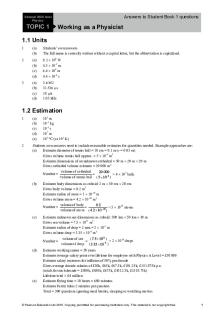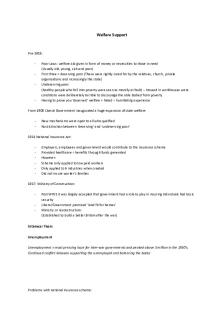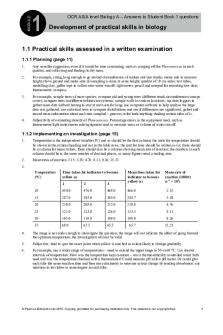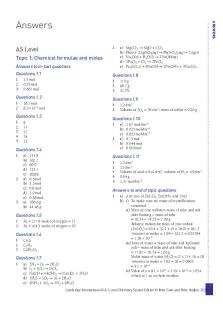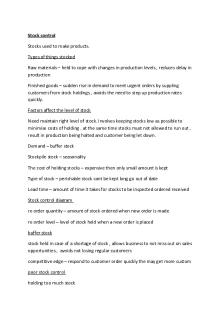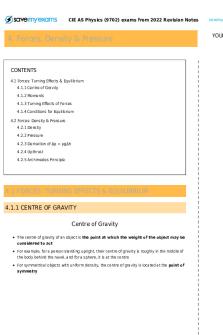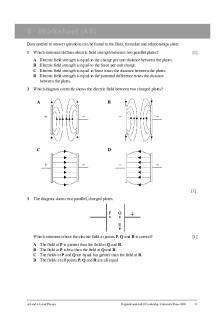Edexcel AS A level Physics Answers Combined PDF

| Title | Edexcel AS A level Physics Answers Combined |
|---|---|
| Author | Staś Dutkiewicz |
| Course | ICT in Marketing |
| Institution | НИУ ВШЭ Москва |
| Pages | 34 |
| File Size | 636.2 KB |
| File Type | |
| Total Downloads | 90 |
| Total Views | 177 |
Summary
Yykyk...
Description
Answers to Student Book 1 questions
Edexcel AS/A level Physics
TOPIC 1
Working as a Physicist
1.1 Units 1
(a) (b)
Students’ own answers The full name is correctly written without a capital letter, but the abbreviation is capitalised.
2
(a) (b) (c) (d)
9.2 109 W 4.3 10-2 m 6.4 106 m 4.4 10-8 s
3
(a) (b) (c) (d)
3.6 MJ 31.536 s 10 A 1.05 kHz
1.2 Estimation 101 m 10-1 kg 10-1 s 107 m 101 C (or 102 K)
1
(a) (b) (c) (d) (e)
2
Students own answers need to include reasonable estimates for quantities needed. Example approaches are: (a) Estimate diameter of tennis ball = 10 cm = 0.1 m (r = 0.05 m) Gives volume tennis ball approx. = 5 10-4 m3 Estimate dimensions of an unknown cathedral = 50 m 20 m 20 m Gives cathedral volume estimate = 20 000 m3 Number =
volume of cathedral 20 000 = ≈ 4 107 balls volume of tennis ball ( 5 10 4 )
(b)
Estimate body dimensions as cuboid: 2 m 50 cm 20 cm Gives body volume = 0.2 m3 Estimate radius of atom = 1 10-10 m Gives volume atom = 4.2 10-30 m3 0. 2 volume of body Number = ≈ 5 1028 atoms = volume of atom ( 4.2 10 30 )
(c)
Estimate unknown sea dimensions as cuboid: 500 km 50 km 30 m Gives sea volume = 7.5 1011 m3 Estimate radius of drop = 2 mm = 2 10-3 m Gives volume drop = 3.35 10-8 m3 Number =
(d)
(e)
volume of sea ( 7. 5 1011 ) ≈ 2 1019 drops = 8 volume of drop (3 .35 10 )
Estimate working career = 50 years Estimate average salary point over lifetime for employee with Physics A Level = £30 000 Estimate salary increases for inflation of 50% per decade Gives average decade salaries of £30k, £45k, £67.5k, £101.25k, £151.875k p.a. (totals for each decade = £300k, £450k, £675k, £1012.5k, £1518.75k) Lifetime total ≈ £4 million Estimate flying time = 10 hours = 600 minutes Estimate Fermi takes 2 minutes per question Total = 300 questions ignoring meal breaks, sleeping or watching movies
© Pearson Education Ltd 2015. Copying permitted for purchasing institution only. This material is not copyright free.
1
Answers to Student Book 1 questions
Edexcel AS/A level Physics
TOPIC 2
Mechanics
2.1 Motion 2.1.1 Velocity and acceleration 1
2
3
(a) (b)
8.33 m s−1 2.08 m s−1
(c)
zero
(a)
11 m s−1
(b) (c)
1.5 s 4.4 m s−2 (accept 4.5 m s−2)
(a) (b)
1.5 × 108 m s−1 8.82 × 1022 m s−2
2.1.2 Motion graphs 1
A: The bike is at constant speed for the first 10 s (2 m s−1) B: The bike is stationary from 10 s to 30 s (20 m distance) C: The bike is at constant speed from 30 s to 40 s (3 m s−1) The bike finishes stationary.
2
A: The car has constant acceleration for the first 10 s (0.5 m s−2) B: The car is at constant speed from 10 s to 30 s (5 m s−1) C: The car has constant acceleration from 30 s to 40 s (1 m s−2) D: The car has constant deceleration from 40 s to 50 s (−1.5 m s−2)
3
(a)
d = 240 m
2.1.3 Adding forces 1
12.1 N forwards
2
6621 N at an angle of 65.0° up from the horizontal
3
Students should draw the weight force arrow vertically down from centre of body, exactly the same size as the reaction force from the chair acting vertically upwards on bottom.
4
(a) (b)
5
4100 N, 4° left of the forwards direction
800 N, θ = 18° (accuracy depends on quality of scale drawing) As part (a)
2.1.4 Moments 1
438 Nm
2
1.51 m
3
If the book swings past the position of the second picture, a moment will then act against the motion, slowing it and pushing it back towards that position with the diagonal vertical. Thus it will oscillate back and forth until it comes to rest as in the second picture. In reality the swinging is likely to be minimal as the finger friction will be significant.
4
55 cm
© Pearson Education Ltd 2015. Copying permitted for purchasing institution only. This material is not copyright free.
1
Answers to Student Book 1 questions
Edexcel AS/A level Physics
TOPIC 2
Mechanics
2.1.5 Newton’s laws of motion 1
In terms of Newton’s laws of motion: (a) Weight balanced by reaction force, so resultant force = zero, so acceleration = zero, as per Newton’s first law of motion. (b) It will accelerate upwards, as per Newton’s first law. (c) Newton’s third law: the book will offer an equal and opposite force to that of the hands on the book. Touch sensors in the skin detect this reaction force.
2
(a) (b)
0.5 kg accelerating force of 0.5 N
3
(a) (b) (c) (d)
a = 65.4 m s−2 a = 7.16 m s−2 a = 9.80 m s−2 a = 179 m s−2
2.1.6 Kinematics equations 1
4 m s−1
2
40 m
3
(a) (b) (c)
a = 5.8 m s−2 a = 0.384 m s−2 a = 0.89 m s−2
4
4.24 s
5
−122 m s−2
2.1.7 Resolving vectors 1
7.1 cm = 7.1 m s−1 for each arrow
2
horizontal = 13.1 m s−1; vertical = 9.18 m s−1
3
horizontal = 207 N; vertical = 388 N
4
138 m s−1 southwards vector 197 m s−1 eastwards vector
2.1.8 Projectiles 1
(a) (b)
0.98 s 1.17 m
2
(a) (b)
1.92 s 5.94 m
3
(a) (b)
It will rise 1.08 m, so yes. No. The horizontal velocity is 3.86 m s−1. horizontal time of flight is 0.78 s. Time to maximum height is 0.47 s. time from max height to horizontal hoop distance is 0.31. In 0.31 s, the ball falls 0.47 m, so the ball will be below the hoop when it reaches it horizontally. (Even accounting for the diameter of the ball, it would not hit the hoop.)
© Pearson Education Ltd 2015. Copying permitted for purchasing institution only. This material is not copyright free.
2
Answers to Student Book 1 questions
Edexcel AS/A level Physics
TOPIC 2
Mechanics
2.1 Answers to Exam-style questions 1
(c)
2
(c)
3
(b)
4
(a) (b)
Magnitude and direction Direction changing / not a straight line, so velocity is changing / not constant.
5
(a)
W = mg W = 3.04 × 106 kg × 9.81 kg m s–2 = 2.98 × 107 N Resultant force = 3.4 × 107 N – 2.98 × 107 N = 4.2 × 106 N
(b)
a=
F m
= 4.2 × 106 N / 3.04 × 106 kg = 1.38 m s–2 (c)
a= =
(v u ) t
( 2390 m s 1 0) 150 s
= 15.9 m s–2
6
7
(d)
Any one from: mass decreasing / weight decreasing / net upward force increasing / fuel used up / gets lighter / g decreasing / air resistance decreasing with altitude
(a)
Ruler to measure length of trolley and a light gate (connected to computer / data logger) to measure time for the trolley to pass.
(b)
Human error in using stopwatch, but no human error using ICT. Different reaction time for different people, or on different occasions.
(a)
QWC – Work must be clear and organised in a logical manner using technical wording where appropriate; including: state sufficient quantities to be measured (e.g. s and t or v, u and t or u, v and s) relevant apparatus (includes ruler and timer/data logger/ light gates) describe how a distance is measured describe how a speed or time is measured further detail of measurement of speed or time vary for described quantities and plot appropriate graph state how result calculated Repeat and calculate the mean. A suitable precaution relating to experimental procedure.
(b)
© Pearson Education Ltd 2015. Copying permitted for purchasing institution only. This material is not copyright free.
3
Answers to Student Book 1 questions
Edexcel AS/A level Physics
TOPIC 2 8
(a)
Mechanics
Draw a tangent at t = 4.0 s: v=
(32 m 0 m ) (6 .0 2 .0 s)
= 8.0 m s–1 (b)
a=
=
(v u ) t
(8 .0 m s 1 0 ) 4s
= 2 m s–2 9
(a) (b)
(i) Area under graph between 0.5 and 1.0 s / X and Y, or use average velocity between these points × time (ii) Gradient of line at Y QWC – Work must be clear and organised in a logical manner using technical wording where appropriate. Include up to four of the following: Lines not parallel Acceleration should be the same/both should have same gradient Max +ve and -ve speeds (from 0.5 s) all the same There will be some energy losses (bounce, air resistance) so max should have smaller magnitude each time Velocity at X/Z greater than that at the start Ball cannot gain energy Starts with positive velocity but initial movement is down Starts with non-zero velocity / graph starts in wrong place From photo, it is dropped from rest There is a vertical line Bounce must take some time / acceleration can’t be infinite The graph shows a change in direction of velocity between 0 and 0.5 s / release and striking the ground It is travelling in one direction / down this whole time Graph shows an initial deceleration It is actually accelerating downwards.
10
(a)
s = ut + ½at2 a=
2 2 500 000 m (( 30 60)s) 2
= 1.54 m s–2 (b)
v = u + at
= 0 + 1.5 m s–2 × (30 × 60)s = 1.5 m s–2× (30 × 60)s = 2700 m s–1 (c)
F = ma
= 4.5 × 105 kg × 1.5 m s–2 = 675 000 N
© Pearson Education Ltd 2015. Copying permitted for purchasing institution only. This material is not copyright free.
4
Answers to Student Book 1 questions
Edexcel AS/A level Physics
TOPIC 2
Mechanics
11
QWC – Work must be clear and organised in a logical manner using technical wording where appropriate, including the following points: No acceleration / constant velocity (‘constant speed’ not sufficient) / (at rest or) uniform motion in straight line unless unbalanced /net / resultant force acceleration proportional to force / F = ma Qualify by stating resultant/net force / ΣF = ma If (resultant) force zero, then Newton’s 2nd law states that acceleration = 0 OR acceleration only non-zero if (resultant) force non-zero.
12
(a)
(i)
(ii)
(iii)
v=
1.83 m 0.88 s
= 2.14 m s–1 v = u + at 0 = u + (–9.81 ms–2) × 0.44 s u = 9.81 m s–2 × 0.44 s = 4.3 m s–1 OR s = ut + ½at2 0 = (u × 0.88 s) + (½ × (–9.81 ms–2) × (0.88s)2) u = 4.3 m s–1 velocity2 = (2.1 m s–1)2 + (4.3 m s–1)2 velocity = 4.8 m s–1 tan of angle =
(b)
(i)
(ii)
4.3 m s 1 2.1 m s1
angle = 63.9º Air resistance has not been taken into account OR air resistance acts on the rocket OR friction of the rocket on the stand has not been taken into account OR energy dissipated/transferred due to air resistance. Any two from: Can watch again Can slow down / watch frame by frame / stop at maximum height Too fast for humans to see Does not involve reaction time Can zoom in (to see height reached).
© Pearson Education Ltd 2015. Copying permitted for purchasing institution only. This material is not copyright free.
5
Answers to Student Book 1 questions
Edexcel AS/A level Physics
TOPIC 2
Mechanics
2.2 Energy 2.2.1 Gravitational potential and kinetic energies 1
If we assume that the coconut falls 5.0 m, then the speed would be 9.9 m s−1.
2
17.2 m s−1
3
29.7 m s−1
4
1.90 m
5
Air resistance and friction are negligible; energy is only interconverted between kinetic and gravitational potential forms.
2.2.2 Work and power 1
(a) (b)
Work done by lioness is 12.9 J. Work done by eagle is 11.6 J, so lioness does more work by 1.3 J.
2
4160 J
3
(a) (b)
4
0.29 or 29%
0.20 W 0.33 or 33%
2.2 Answers to Exam-style questions 1
(a)
2
(a)
3
(b)
4
(a)
(b)
(c)
(d)
Wind exerts a force / push on the blades, blades move (through a distance in the direction of the force) OR Energy is transferred from kinetic energy of wind to (KE of) the blades. (i) Volume per second = 6 000m2 × 9 m = 54 000m3 Total volume in 5 seconds = 54 000m3 × 5 s = 270 000 (m3) (ii) Mass = 1.2 kg m–3 × 270 000 m3 = 324 000 kg (iii) Ek = ½ × 324 000 kg × (9 m s–1)2 = 13 122 000 J (iv) Energy from the wind in 5 seconds = 0.59 × 13 100 000 J = 7 741 980 J Power = energy/second = 7 741 980 J/5s = 1.548 MW Any one from: Would need to stop wind entirely Wind or air still moving Wind or air still has KE Not all the air hits the blades. Any two from: ● Wind doesn’t always blow / if there is no wind they don’t work / wind speeds are variable / need minimum amount of wind to generate the electricity / need a large amount of wind / can’t be used in very high winds. ● Only 59% max efficiency ● Low power output / need a lot of turbines / need a lot of space.
© Pearson Education Ltd 2015. Copying permitted for purchasing institution only. This material is not copyright free.
6
Answers to Student Book 1 questions
Edexcel AS/A level Physics
TOPIC 2 5
(a)
Mechanics
work = force × distance = 150 N × 2.5 × 10–2 m = 3.75 J
(b)
(c)
3.75 J = ½ × 0.0075 kg × v2 v2 = 1000 m2 s–2 v = 31.6 m s–1 (i) vv = v sin θ
(ii)
= 32 m s–1 × sin 40º = 20.6 m s–-1 vh = v cos θ = 32 m s–1 × cos 40º = 24.5 m s–1 Time to max height, t = (v – u)/a = 20.6 m s-1 / 9.81 m s–2 = 2.1 s Total time = 2 × 2.1 s = 4.2 s range = v × t
(d)
6
(a)
(b)
7
(a)
= 24.5 m s–1 × 4.2 s = 103 m Any plausible suggestions using correct scientific justification, such as: Air resistance / friction on cork as it leaves the bottle Work done → energy dissipated OR air resistance decelerates cork / reduces speed of cork OR friction with bottle reduces acceleration / launch speed OR reduces kinetic energy of the cork. x = 2 × π × 3.7 m = 23.2 m W = FΔx = 800 N × 23.2 m = 18 600 J Power = work done / time = 144 × 18 600 J / 60 × 60 s = 744 W (accept any dimensionally correct unit – ignore later units if W used as well) (use of 20 000 J gives 800 W)
QWC – spelling of technical terms must be correct and the answer must be organised in a logical sequence. Any six of the following: It will not strike the student’s face / at most will just touch / returns to starting point The total energy of the pendulum is constant / energy is conserved It cannot move higher than its starting point because that would require extra gpe Mention specific energy transfer: gpe → ke / ke → gpe Energy dissipated against air resistance so will stop it quite reaching its starting point (consequent on attempt at describing energy loss mechanism) Pushing does work on the ball / pushing provides extra energy if pushed, it can move higher (accept further) and will hit the student If the face moves (forward) the ball may reach it (before it is at its maximum height) OR if the face moves (back) the ball won’t reach it.
© Pearson Education Ltd 2015. Copying permitted for purchasing institution only. This material is not copyright free.
7
Answers to Student Book 1 questions
Edexcel AS/A level Physics
TOPIC 2 8
(a)
(b)
9
Mechanics
(i)
Horizontal component = 650 N × cos 42º = 483 (N) (ii) Work = 483 N × 15 × 7 m = 50 715 J Force in the direction of motion OR Force is parallel to the direction of motion OR Force is applied in a horizontal direction OR There is no vertical component of force So less applied force
W = mg W = 0.98 N OR W = 0.1 (kg) × 9.81 (N kg-1) = 1 N W = Fs OR gpe = mgh gpe = 0.98 J P = W/t P = 0.98 W
2.3 Momentum 2.3.1 Momentum 240 kg m s−1 588 kg m s−1 2.5 × 10−4 kg m s−1
1
(a) (b) (c)
2
Motorcyclist: estimate mass as 80 kg and speed as 30 ms−1, so p = 2 400 kgms−1. Skateboarder: estimate mass as 65 kg and speed as 4 ms−1, so p = 260 kgms−1.
3
4
Larger forces cause greater injuries. Force required is proportional to rate of change of momentum (Newton II). The airbag removes momentum in a greater time than the dashboard, so the rate of change of momentum is lower, so the force needed is lower, resulting in less injuries. p t For example, a Frisbee’s estimated throw speed is 5 ms−1 (initially at rest); estimated mass is 100g; estimated time for which hand applies force to throw is 0.1s: p 0 .1 5 F= = =5N t 0.1
Students’ own answers, using F =
2.3.2 Conservation of linear momentum 1
0.0315 m s−1
2
(a) (b)
3
The force that pushes the boy forwards from the boat has an equal and opposite reaction force pushing the boat away, so it is likely that the boat will move out from under him without providing enough forward force to make him reach the jetty before he falls into the water.
4
(a)
0.2 m s−1 100 N
Longer arrow labelled ‘1200 kg m s−1’ at 80° to shorter arrow labelled ‘600 kg m s−1’. Either drawn as parallelogram rule, or one after the other, with resultant momentum vector arrow drawn in. Resultant is 1430 kg m s−1 at an angle of 56° to the river current (600 kg m s−1 vector).
© Pearson Education Ltd 2015. Copying permitted for purchasing institution only. This material is not copyright free.
8
Answers to Student Book 1 questions
Edexcel AS/A level Physics
TOPIC 2 (b)
Mechanics
Resulting velocity = 4.77 m s−1 at 56° to current, so 2.67 m s−1 along current direction and 3.94 m s−1 towards riverbank. Time to reach waterfall = 37 s. Time to reach bank = 4.1 s, so they reach the bank safely.
2.3 Answers to Exam-style questions 1
(b)
2
(a)
3
(b)
4
QWC – Spelling of technical terms must be correct and the answer must be organised in a logical sequence Momentum conservation Total/initial momentum = 0 Momentum of slime equal momentum of bacteria, which moves in opposite direction OR Force on slime, so equal and opposite force on bacteria. Thus cause the rate of change of momentum Δmv/t to bacteria, which moves in opposite direction.
5
(a)*
(b)
6
7
QWC – Work must be clear and organised ...
Similar Free PDFs
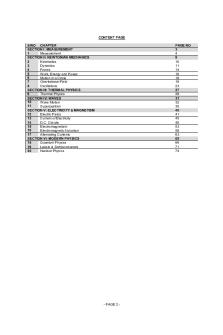
AS A Level Topical Physics Notes
- 77 Pages
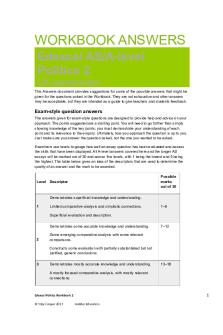
Politics Edexcel Workbook 2 Answers
- 43 Pages

A level politics example answers
- 128 Pages
Popular Institutions
- Tinajero National High School - Annex
- Politeknik Caltex Riau
- Yokohama City University
- SGT University
- University of Al-Qadisiyah
- Divine Word College of Vigan
- Techniek College Rotterdam
- Universidade de Santiago
- Universiti Teknologi MARA Cawangan Johor Kampus Pasir Gudang
- Poltekkes Kemenkes Yogyakarta
- Baguio City National High School
- Colegio san marcos
- preparatoria uno
- Centro de Bachillerato Tecnológico Industrial y de Servicios No. 107
- Dalian Maritime University
- Quang Trung Secondary School
- Colegio Tecnológico en Informática
- Corporación Regional de Educación Superior
- Grupo CEDVA
- Dar Al Uloom University
- Centro de Estudios Preuniversitarios de la Universidad Nacional de Ingeniería
- 上智大学
- Aakash International School, Nuna Majara
- San Felipe Neri Catholic School
- Kang Chiao International School - New Taipei City
- Misamis Occidental National High School
- Institución Educativa Escuela Normal Juan Ladrilleros
- Kolehiyo ng Pantukan
- Batanes State College
- Instituto Continental
- Sekolah Menengah Kejuruan Kesehatan Kaltara (Tarakan)
- Colegio de La Inmaculada Concepcion - Cebu
